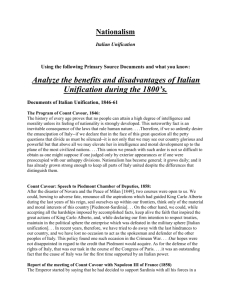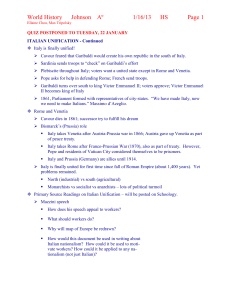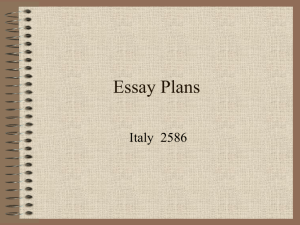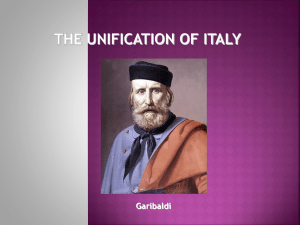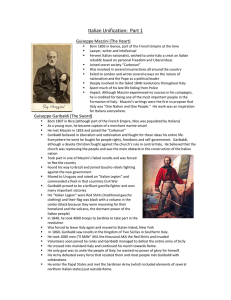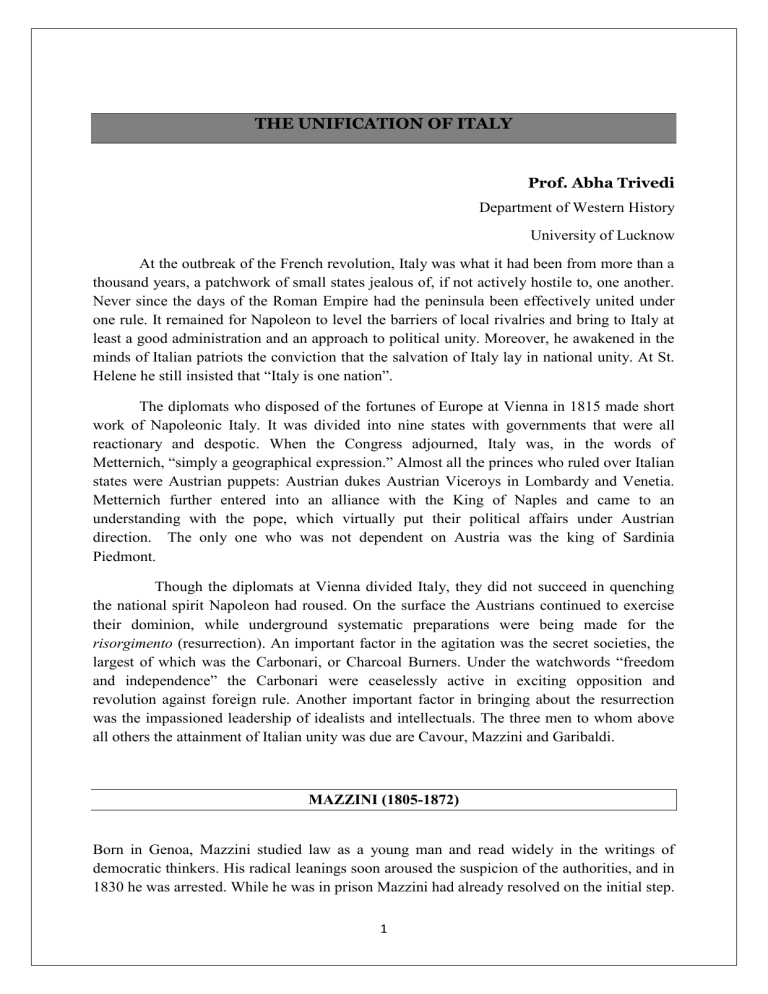
THE UNIFICATION OF ITALY Prof. Abha Trivedi Department of Western History University of Lucknow At the outbreak of the French revolution, Italy was what it had been from more than a thousand years, a patchwork of small states jealous of, if not actively hostile to, one another. Never since the days of the Roman Empire had the peninsula been effectively united under one rule. It remained for Napoleon to level the barriers of local rivalries and bring to Italy at least a good administration and an approach to political unity. Moreover, he awakened in the minds of Italian patriots the conviction that the salvation of Italy lay in national unity. At St. Helene he still insisted that “Italy is one nation”. The diplomats who disposed of the fortunes of Europe at Vienna in 1815 made short work of Napoleonic Italy. It was divided into nine states with governments that were all reactionary and despotic. When the Congress adjourned, Italy was, in the words of Metternich, “simply a geographical expression.” Almost all the princes who ruled over Italian states were Austrian puppets: Austrian dukes Austrian Viceroys in Lombardy and Venetia. Metternich further entered into an alliance with the King of Naples and came to an understanding with the pope, which virtually put their political affairs under Austrian direction. The only one who was not dependent on Austria was the king of Sardinia Piedmont. Though the diplomats at Vienna divided Italy, they did not succeed in quenching the national spirit Napoleon had roused. On the surface the Austrians continued to exercise their dominion, while underground systematic preparations were being made for the risorgimento (resurrection). An important factor in the agitation was the secret societies, the largest of which was the Carbonari, or Charcoal Burners. Under the watchwords “freedom and independence” the Carbonari were ceaselessly active in exciting opposition and revolution against foreign rule. Another important factor in bringing about the resurrection was the impassioned leadership of idealists and intellectuals. The three men to whom above all others the attainment of Italian unity was due are Cavour, Mazzini and Garibaldi. MAZZINI (1805-1872) Born in Genoa, Mazzini studied law as a young man and read widely in the writings of democratic thinkers. His radical leanings soon aroused the suspicion of the authorities, and in 1830 he was arrested. While he was in prison Mazzini had already resolved on the initial step. 1 Having lost faith in Carbonarism, whose leaders were largely men of advanced years, he decided to entrust the cause of Italy to youthful minds and hands. He organised among the Italian exiles in Marseilles a society called Young Italy (1832). Friends established the first lodge at Genoa, from there it spread rapidly through all northern and central Italy, attracting mostly students, young professional men, and youths of the mercantile classes. The banner of the organisation bore on one side the words “Unity and Independence” and on the other “Liberty, Equality, Humanity”. Within two years the membership grew to more than fifty thousand. Besides founding and directing Yong Italy Mazzini wrote many fervent articles and pamphlets which were smuggled into Italy. The Patriots were at one in the conviction that unity whatever form it might take, could be achieved only through expulsion of the Austrians. CAVOUR (1810-1861) After 1848 the building of Italian unity became essentially the task of the Government of Piedmontese. Count Camillo di Cavour was a Piedmontese by birth. In 1847 he took a definite political step when with several others he founded a journal called II Risorgimento, devoted to securing a constitution for Piedmont. In February 1848, Charles Albert granted the Constitution and in June, Cavour took a seat in the parliament elected under its provisions. In the year 1852 he became prime minister. Cavour at once threw himself heart and soul into the work of regenerating Piedmont and achieving Italian unity. He therefore reorganised the army, built new fortresses and increased the military resources. He also gave much attention to the development of industry and commerce; he built numerous railways, negotiated commercial treaties with France, England, Belgium, Holland, and Switzerland. Moreover by sending an army to Crimea, Piedmont established a strong claim to equality with other states. Cavour attended the Congress of Paris, 1856 and denounced the influence and misgovernment of Austria in the Peninsula. The combined forces of France and Piedmont inflicted a severe defeat on the Austrians at Magenta (June 4) and again at Solferino (June 24, 1859). It seemed as if Austria were about to expelled completely from Italy. Suddenly, however, Napoleon III stopped short and, without consulting his ally, concluded the armistice of Villafranca (July 8) with the Emperor Francis Joseph. By the terms of the treaty which was signed at Zurich on November 10, 1859, Lombardy was annexed to Piedmont, but Venetia remained under Austrian rule. Cavour resigned his premiership in a fit of rage but after a retirement of a few months he returned to take up the struggle again. Stirred by the vigour of Piedmontese leadership, Tuscany, Modena and Parma and Romagna revolted against their rulers and unanimously declared for union with Piedmont. Cavour gained Napoleon III’s consent to this by the surrender of Savoy and Nice. Victor Emanuel then accepted the annexation of the four Italian states, and on April 2, 1860, an enlarged parliament, representing nearly half the population of the Peninsula, met at Turin. 2 GIUSEPPE GARIBALDI (1807-1882) The next step in the unification of Italy was taken by Garibaldi. As a young man he joined the society of Young Italy and participated in an attempted insurrection at Genoa in 1833. Condemned to death he managed to escape the country and in 1834 went to South America. There he gained the knowledge of guerrilla fighting that was to serve him so well in the conquest of Sicily and Naples. He collected at Genoa a thousand “Red Shorts”, so called because of the colour of their uniform, and in May 1860, landed his expedition in Sicily. The opposition he met was overcome so quickly that he was master of the island in a few weeks, after which he crossed to the mainland and advanced almost unopposed on Naples. At his approach Francis II fled and garibaldi entered the capital amidst the joyful acclaim of the populace. After a plebiscite declared for annexation by an almost unanimous vote, Victor Emmanuel II with garibaldi at his side rode into Naples early in November to make the annexation official. Garibaldi now felt that his work was done. Refusing all honours and rewards he withdrew to his island. Meanwhile the rest of the Papal States, excepting Rome and a small district around it, had also been occupied by Piedmontese troops. On February 18, 1861, the first national parliament representing the north and south met at Turin amid fervent enthusiasm the united kingdom of Italy was proclaimed on March 17, and Victor Emmanuel II was officially styled “by the grace of God and the will of the nation king of Italy.” The more difficult part of the work of unification was over. Only Venetia and Rome were still outside the new kingdom. When Bismarck was ready to crush Austria in 1866, he concluded an alliance with Italy, whose reward for fighting on Prussia’s side was to be Venetia. The Italians were defeated by the Austrians both on land and on sea; but the Prussian victory at (Sadowa) Koniggratz (July 3, 1866) was so overwhelming that Prussia won the war, and the new kingdom of Italy received Venetia. Four years later the acquisition of Rome was made possible by the exigencies of the Franco-Prussian war, 1870. In July, 1871, Victor Emmanuel entered the Eternal City with the cheers of the people. The dream of Cavour and the Italian patriots, which a quarter of a century earlier had provoked smiles in the diplomatic circles of Europe, was fulfilled. STAGES OF UNIFICATION I. Lombardy- War of Liberation, 1859. The French Alliance, secured by Cavour at Phombieres in 1858, was a necessary factor in success. 200,000 French troops crossed the Alps, the Austrians were routed at Magenta and retreated to quadrilateral. Napoleon III won at great cost another 3 II. III. IV. V. VI. victory at Solferino, and immediately concluded a pact at Villafranca, by which Lombardy passed from Austria to Sardinia. The Three Duchies and Romagna- Diplomacy,1860 Parma, Modena, Tuscany, and the Papal State of Romagna joined Sardinia-Piedmont in 1860. Napoleon III received Nice and Savoy. Sicily and Naples- Garibaldi, 1860 Garibaldi landed at Marsala, acquired Sicily at the battle of Calatafimi, and crossed the Straits and advance to Naples with the avowed intention of crowning Victor Emmanuel at Rome. Marches and Umbria- Cavour, 1860 Cavour intervened to check the reckless project of Garibaldi, which would have antagonized Austria and France. He despatched the Sardinian King and army through the Papal States, where the Papal army was defeated at Castel Fidardo, to intercept Garibaldi’s advance on Rome. Fortunately for Cavour and Italy, Garibaldi was delayed a fortnight on the Volturno by the Neapolitan army. After defeating this army he met Victor Emmanuel at Teano and magnanimously handed over Southern Italy. Kingdom of Italy was set up, 1861 Venetia- Austro- Prussian War, 1866 Austria was the common obstacle to unification in Italy and Germany. Bismarck secured an Italian Alliance, 1866. The Treaty of Prague transferred Venetia (without Southern Tyrol) to Italy. Rome- Franco- Prussian War, 1870 France had now become the common obstacle to German and Italian unification, for after Garibaldi’s two attempts to seize Rome (1862- Aspromonte; 1867-Mentana), French troops occupied the city. On the withdrawal of French troops, Victor Emmanuel entered Rome. In 1872 Rome was made the capital of the Italian kingdom. 4
